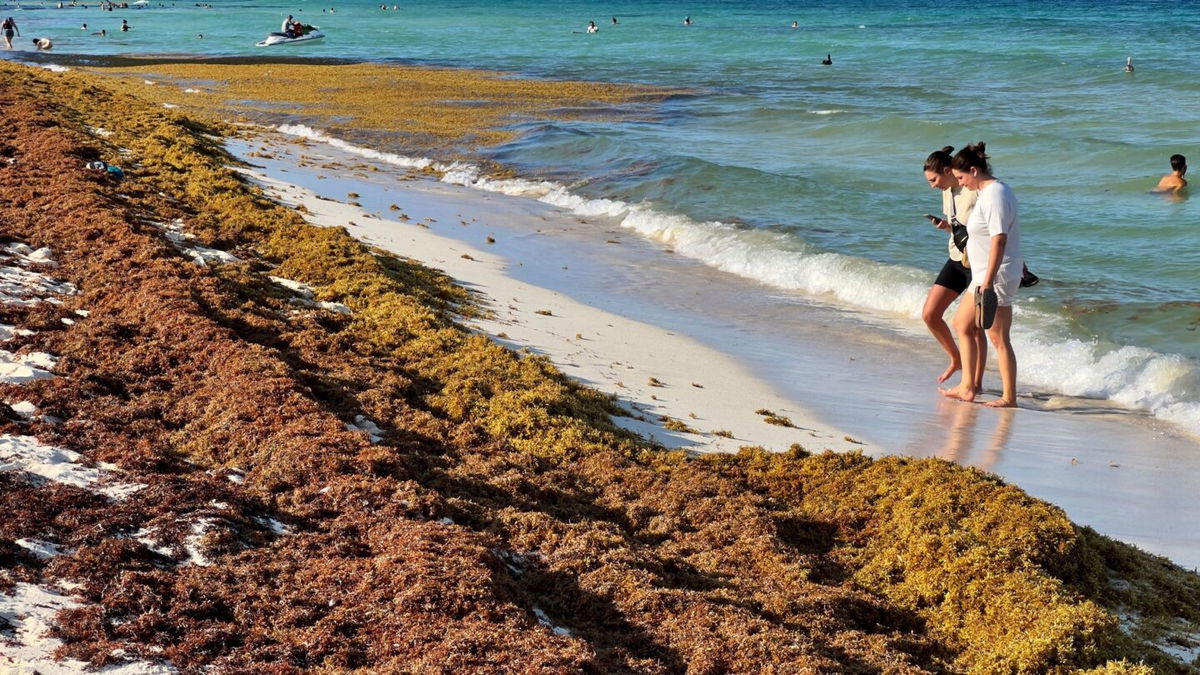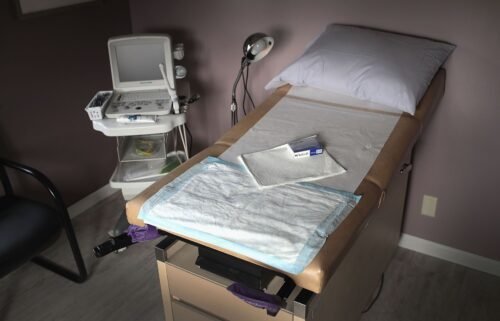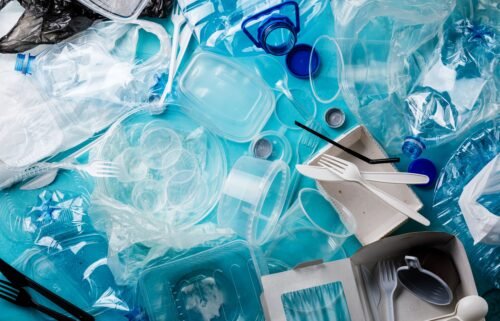What you should know about flesh-eating bacteria on beaches

Sargassum algae piles up along the shore at a beach in Cancun on May 23.
By Kristen Rogers, CNN
(CNN) — The giant seaweed blob that has been piling up on beaches on the Florida coast — posing risks to sea life, human respiratory health and tourism — could carry an added threat: illness-inducing bacteria.
Sargassum, a specific variety of seaweed, has long formed large blooms in the Atlantic Ocean, and scientists have been tracking massive accumulations since 2011. But at twice the width of the United States, this year’s bloom is the largest ever, collectively spanning more than 5,000 miles (8,047 kilometers) from the shores of Africa to the Gulf of Mexico.
When adrift at sea, sargassum can serve as a habitat, providing food and protection for animals such as fish, mammals, crabs and marine birds, according to the Sargassum Information Hub, a joint project among various research institutions.
But when it accumulates and starts decomposing on shore, there can be downsides. The interaction between sargassum, plastic marine debris and bacteria of the Vibrio genus “creates the perfect ‘pathogen’ storm that has implications for both marine life and public health,” according to a news release for a May study published in the journal Water Research.
The researchers conducting the study, most of whom were affiliated with Florida Atlantic University, explored a scenario about which little was known: whether Vibrio bacteria — including the variety commonly known as flesh-eating bacteria — that colonized sargassum and plastic debris could infect humans.
Vibrio bacteria risks
Vibrio bacteria naturally occur in some coastal waters and reach higher concentrations when water temperatures are warmer, between May and October, according to the US Centers for Disease Control and Prevention. Out of more than 100 Vibrio species, about 12 — the most common in the US being Vibrio vulnificus, Vibrio parahaemolyticus and Vibrio alginolyticus — can cause a human illness known as vibriosis. People can get vibriosis by eating raw, undercooked or improperly stored shellfish — especially oysters — or when an open wound is exposed to salt water or brackish water, a mixture of freshwater and saltwater, according to the CDC.
Vibrio vulnificus is the species that can cause flesh-eating infections, known as necrotizing fasciitis. “When we talk flesh-eating, it’s not like you can track this and then you’re watching your fingers fall off, like a leprosy,” said Jae Williams, press secretary for the Florida Department of Health, who wasn’t involved in the recent study. “It’s eating your organs from the inside out. That’s what’s deteriorating.”
In studying potential ocean-related risks to humans, the researchers isolated 16 varieties of Vibrio colonies from eel larvae, plastic marine debris, sargassum and seawater taken from the Caribbean and Sargasso seas of the North Atlantic Ocean.
“Our lab work showed that these Vibrio are extremely aggressive and can seek out and stick to plastic within minutes,” said lead study author Tracy Mincer, an assistant professor of biology at Florida Atlantic University’s Harbor Branch Oceanographic Institute, in a news release. “We also found that there are attachment factors that microbes use to stick to plastics, and it is the same kind of mechanism that pathogens use.”
The authors didn’t find flesh-eating bacteria in the sargassum samples, but that doesn’t rule out the bacteria being present in any sargassum they didn’t test, said study coauthor Linda Amaral-Zetter, chair of marine microbiology at the University of Amsterdam, via email.
And Vibrio vulnificus bacteria would most likely be in any brackish water on or around the sargassum rather than in the sargassum itself, Williams said.
“It’s not that the seaweed itself is harmful to humans, but it creates an environment that can be harmful to humans,” Williams said. As sargassum moves through the sea, it picks up everything in its path, he added, and that can include garbage, debris or decomposing or dead marine life.
As sargassum drifts onto shore, it’s also holding some degree of water, and this combination baking in the Florida sun creates the perfect environment for Vibrio bacteria to cultivate, Williams said.
“This is not, like, another (Covid-scale concern) by any means,” Williams said. “The sky is not falling. Frankly, this is just kind of solidifying and reiterating what the state agencies have been saying for months — if you stay away from it, it’s easily avoidable.”
Avoiding bacteria on beaches
The study authors’ finding related to Vibrio bacteria on plastic is concerning because, if plastic fragments are sharp enough, they can cut you, Williams said. Vibrio bacteria can enter through even minor wounds, including cuts, scrapes, scratches, recent piercings, new tattoos or surgical incisions.
Vibriosis isn’t contagious, but it causes about 80,000 illnesses annually in the US, according to the CDC. More than half of these result from eating contaminated food, and Vibrio parahaemolyticus is the species responsible for 45,000 of these cases.
Infections from Vibrio vulnificus are rare, according to the Florida Department of Health. The state has seen 10 cases this year of Vibrio vulnificus infections, two of which resulted in death, as of June 2. A spike last year, which amounted to 74 cases and 17 deaths, was due to the impacts of Hurricane Ian.
Even though the risk of a Vibrio vulnificus infection is low, if contracted the effects can be severe. This infection can cause serious illness sometimes leading to intensive care or limb amputation, according to the CDC. Around 1 in 5 people infected with Vibrio vulnificus die, sometimes within a day or two of getting sick.
Given all these concerns, neither people nor pets should play in sargassum or stagnant tide pools with sargassum in them, especially if these areas smell bad, Williams said. Don’t sit near sargassum either, since the gas emitted from the rotting algae — hydrogen sulfide — is toxic and can cause respiratory problems if ingested.
If you don’t have any open wounds, you should be OK to swim in oceans with sargassum, since that environment is moving saltwater instead of brackish water, he added. But if you see a clump go by, stay away from it. Don’t swim in waters that appear filthy.
If you have open wounds and must wade through sargassum for whatever reason, cover your wounds with waterproof bandages, Williams and the CDC advise. Afterward, immediately uncover them and thoroughly disinfect them.
If after visiting a sargassum-laden beach “you feel not well a day or two later, even if it’s minor — like a headache or a fever or a stomachache — go to the doctor,” Williams added. People with Vibrio vulnificus infections might also experience dizziness, nausea or vomiting, balance problems, diarrhea, chills, low blood pressure, or blistering skin lesions, according to the CDC.
Vibriosis is treatable, “but it has to get treated pretty early on,” Williams said. “Don’t mess around.”
The-CNN-Wire
™ & © 2023 Cable News Network, Inc., a Warner Bros. Discovery Company. All rights reserved.



